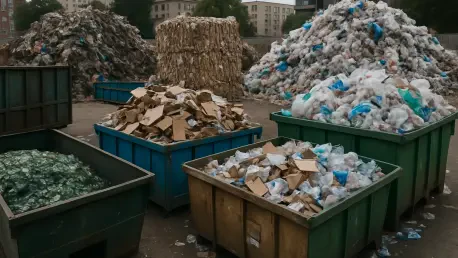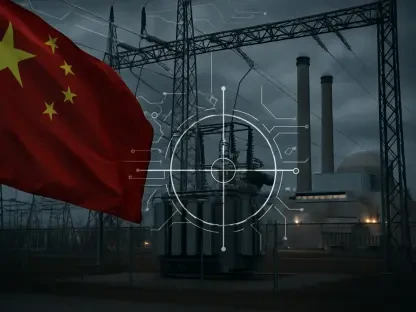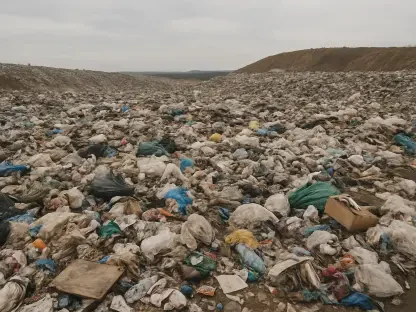In a nation grappling with the dual challenges of rapid urbanization and mounting waste, China has emerged as a global leader in transforming discarded materials into valuable resources through the innovative practice of urban mining. This concept, which involves extracting metals, plastics, and other materials from waste streams like old electronics and scrapped vehicles, is redefining sustainability by treating trash as a hidden treasure. Far from being just a recycling trend, urban mining lies at the heart of China’s ambitious circular economy, a model aimed at minimizing waste and maximizing resource reuse. It offers a compelling solution to environmental degradation while spurring economic growth in industrial hubs. A prime example is the Tianjin Ziya Circular Economy Industrial Park, where cutting-edge technology and progressive policies converge to turn waste into wealth. This article explores the multifaceted role of urban mining in driving China’s circular economy, examining its historical roots, technological advancements, and the broader economic and environmental impacts. By delving into the synergy of government support, generational shifts in mindset, and international collaboration, the discussion reveals how this practice is not only reshaping waste management but also positioning China as a pioneer in sustainable industrial development. The journey from toxic, rudimentary practices to sophisticated, eco-friendly operations underscores a profound transformation, one that balances profitability with planetary health and sets a benchmark for global sustainability efforts.
Tracing the Path of Waste Management Transformation
The history of waste management in China paints a vivid picture of evolution, from hazardous, unregulated practices to a structured, sustainable industry. In the mid-20th century, recycling often meant burning wires in open fields to salvage copper, a process that released toxic fumes and forced nearby residents to seal their homes against the acrid smoke. These early methods, driven by necessity and a lack of environmental awareness, prioritized immediate financial gain over long-term ecological consequences. The health risks were immense, with workers and communities bearing the brunt of pollution from such crude techniques. Fast forward to the present, and the contrast couldn’t be starker. Industrial zones like the Tianjin Ziya Circular Economy Industrial Park have become symbols of progress, where waste is processed under strict environmental standards. This shift reflects not only technological growth but also a societal awakening to the need for cleaner practices, spurred by decades of learning from past mistakes and a growing recognition of sustainability as a national priority.
Another layer of this transformation lies in the regulatory framework that now underpins the industry. Where once small-scale, informal operations dominated, often at great environmental cost, today’s waste management sector operates within a tightly governed system designed to curb pollution. The Ziya Park, for instance, exemplifies how standardized processes have replaced chaotic, backyard recycling. Established as a national-level economic zone, it hosts hundreds of companies that adhere to rigorous guidelines, ensuring that materials are recovered without compromising air or soil quality. This move toward formalization has also attracted investment, turning waste management into a legitimate economic sector. Beyond just cleaning up the industry, these changes have fostered public trust, demonstrating that recycling can be both profitable and responsible. The historical arc from dangerous improvisation to regulated innovation highlights a critical turning point in China’s journey toward a circular economy, setting the stage for further advancements in resource recovery.
Technology Driving the Urban Mining Revolution
Technology stands as the linchpin of urban mining’s success in China, turning what was once considered refuse into high-value resources for cutting-edge industries. At the forefront of this revolution are companies like Sinone Co, based in Tianjin, which has developed a groundbreaking copper smelting technique achieving a purity level of 99.995%. This isn’t merely about recycling; it’s about producing materials that meet the stringent demands of sectors like aerospace and electric vehicle manufacturing. Such advancements signify a leap beyond traditional waste processing, enabling recycled materials to compete with virgin resources in quality and application. The precision and scalability of these technologies are reshaping perceptions of what recycled goods can achieve, proving that sustainability and high performance are not mutually exclusive.
Equally impressive is the efficiency brought by automation in urban mining operations. Facilities in the Ziya Park, for example, can dismantle an entire vehicle in just 60 seconds using state-of-the-art machinery, a feat that showcases the speed and capacity of modern recycling. This level of mechanization not only boosts throughput—handling millions of tons of waste annually—but also reduces human exposure to hazardous materials, improving worker safety. Moreover, innovations extend to diverse waste streams, from electronics to household appliances, ensuring that a wide array of materials is reclaimed and reintroduced into production cycles. The integration of such technology minimizes landfill dependency and conserves natural resources, aligning with the circular economy’s core principle of closing the loop. As these tools become more widespread, they promise to elevate urban mining’s impact, making it a cornerstone of China’s industrial and environmental strategy.
Dual Benefits: Economic Growth and Environmental Protection
Urban mining’s contribution to the circular economy in China manifests as a powerful synergy of environmental stewardship and economic vitality. The Tianjin Ziya Circular Economy Industrial Park serves as a striking case study, recycling approximately 2 million tons of waste each year across its network of over 900 companies. This massive operation generates a production value of nearly $2.8 billion, illustrating how sustainability can translate into substantial financial returns. Beyond the balance sheet, the park’s activities significantly cut down on pollution by diverting waste from landfills and reducing the need for resource extraction. This dual impact—cleaner ecosystems alongside economic output—underscores the transformative potential of treating waste as a resource rather than a burden, redefining industrial priorities in the process.
The social and economic ripple effects of this model are equally noteworthy. Within the Ziya Park, urban mining initiatives have created around 10,000 jobs, providing livelihoods while fostering community development. These roles span various skill levels, from technical positions in advanced recycling plants to support functions, ensuring broad-based economic inclusion. Environmentally, the reduction in raw material demand helps preserve natural habitats and lowers carbon emissions associated with mining and processing virgin resources. This balance of job creation and ecological benefits positions urban mining as a sustainable growth engine, particularly in industrial regions facing the pressures of urbanization. As more areas adopt similar frameworks, the potential for scaling these gains becomes evident, offering a blueprint for harmonizing economic progress with environmental responsibility across China.
Shifting Mindsets Among Industry Leaders
A profound cultural shift is underway in China’s recycling sector, driven by a new generation of industry leaders who prioritize sustainability over short-term profits. Unlike their predecessors, who often operated under the constraints of survival and focused on immediate gains—frequently at the environment’s expense—today’s innovators embrace a greener philosophy. Figures like Zhang Wenyong of Sinone Co embody this change, advocating for practices that turn waste into valuable resources without polluting. This ethos, centered on making money while safeguarding the planet, marks a departure from past norms where toxic byproducts were an accepted cost of business. The growing emphasis on eco-friendly methods reflects a broader societal push for accountability, reshaping how the industry views its role in national development.
This generational pivot also manifests in operational practices that prioritize responsible waste handling. Modern recycling firms go beyond mere material recovery; they ensure that components like car tires are repurposed and non-recyclable residues are managed as solid waste with minimal environmental impact. Such diligence contrasts sharply with earlier, haphazard approaches that left lasting ecological scars. The shift isn’t just ideological—it’s practical, as companies recognize that sustainable practices can enhance reputation and attract investment. This evolving mindset is critical to embedding circular economy principles into the fabric of China’s industrial landscape, ensuring that urban mining contributes to long-term environmental health. As younger leaders continue to champion these values, the sector stands poised to inspire similar transformations globally, proving that profitability and planetary care can coexist.
Policy Frameworks Supporting Sustainable Progress
Government intervention plays a pivotal role in amplifying urban mining’s impact on China’s circular economy, providing a structured pathway for growth. A recent action plan from the State Council outlines ambitious goals for 2027, including doubling the volume of scrapped vehicle recycling and increasing household appliance recovery by 30% compared to 2023 figures. These targets are backed by commitments to boost equipment investment by 25% across key sectors, ensuring that the infrastructure for large-scale recycling keeps pace with demand. Such policies don’t just set benchmarks; they streamline resource cycles, making high-quality, durable goods more accessible in daily life. This strategic vision reflects a national resolve to integrate sustainability into economic planning, positioning urban mining as a priority.
Beyond setting targets, these policies foster an environment where innovation can thrive. Incentives for adopting advanced technologies and penalties for non-compliance with environmental standards encourage companies to modernize their operations. The focus on smoothing out recycling chains ensures that materials flow seamlessly from waste to reuse, reducing bottlenecks that could hinder progress. Additionally, government support extends to funding research into new recycling methods, further enhancing the sector’s capabilities. This comprehensive approach not only bolsters urban mining’s scalability but also aligns it with broader economic goals, such as reducing reliance on imported raw materials. As these frameworks evolve, they promise to solidify China’s leadership in sustainable waste management, offering a model for other nations to emulate in their pursuit of circular economies.
Global Leadership Through Regional Collaboration
China’s influence in sustainable practices extends far beyond its borders, with urban mining serving as a key pillar of its international outreach. The unveiling of the China-SCO Green Industry Cooperation Platform in Tianjin marks a significant step in sharing expertise with Shanghai Cooperation Organization member countries. This initiative promotes low-carbon, high-recycling development models, focusing on urban mining, remanufacturing, and cross-border resource circulation. By fostering partnerships, such as those with Pakistan, China is building ecosystems for green industries across the region. This collaborative spirit not only amplifies the global impact of its circular economy practices but also positions the nation as a leader in addressing shared environmental challenges through collective action.
The benefits of such international cooperation are manifold, creating a ripple effect of sustainability. Participating countries gain access to advanced technologies and proven frameworks like those developed in the Ziya Park, enabling them to leapfrog outdated waste management practices. In return, China strengthens its diplomatic and economic ties, establishing itself as a hub for green innovation. These efforts also facilitate the exchange of best practices, ensuring that solutions are tailored to diverse regional needs while maintaining a focus on reducing consumption and enhancing recycling. As platforms like the SCO initiative expand, they lay the groundwork for a more interconnected approach to sustainability, demonstrating how urban mining can serve as a universal tool for environmental and economic progress on a global scale.
Synergistic Industrial Models Enhancing Efficiency
Industrial synergy within hubs like the Ziya Park is a driving force behind the success of urban mining in China, creating a seamless ecosystem for resource recovery. By clustering upstream and downstream enterprises, the park enables companies to source raw materials locally and sell byproducts within the same vicinity. Major players like TCL and GEM exemplify this model, benefiting from shortened supply chains that reduce costs and environmental footprints. This closed-loop system maximizes efficiency, ensuring that waste from one process becomes input for another, minimizing loss and enhancing overall productivity. Such integration not only streamlines operations but also fosters a collaborative environment where innovation in recycling practices can flourish.
The impact of this synergistic approach extends to the creation of new business models that capitalize on localized resources. Companies within the park are incentivized to develop complementary processes, such as turning recycled metals into components for nearby manufacturers, thus extending the industrial value chain. This setup reduces transportation emissions and supports the circular economy by keeping materials in use for longer periods. Furthermore, the concentration of expertise and infrastructure attracts investment, spurring growth in sectors like new energy and materials. As a replicable framework, the Ziya Park’s model of industrial collaboration offers insights into how urban mining can underpin sustainable development, providing a template for other regions to adapt and implement in their quest for economic and environmental harmony.
Reflecting on Achievements and Future Horizons
Looking back, the strides made in urban mining within China paint a picture of resilience and reinvention. What began as a sector marked by polluting, rudimentary methods transformed into a sophisticated industry through decades of technological innovation and policy reform. The Tianjin Ziya Circular Economy Industrial Park stands as a beacon of this progress, having recycled millions of tons of waste while generating billions in economic value. Government initiatives played a crucial role, having set ambitious targets that galvanized the sector, while a generational shift toward eco-conscious practices ensured lasting change. Internationally, China’s partnerships under frameworks like the SCO highlight a commitment to shared sustainability, having laid foundations for regional green growth.
Moving forward, the focus should shift to scaling these successes through broader adoption of advanced technologies and deeper international collaboration. Expanding industrial zones like Ziya with new demonstration bases can attract global enterprises, fostering innovation in circular practices. Policymakers might consider incentivizing smaller regions to adopt similar models, ensuring that urban mining’s benefits reach beyond major hubs. Additionally, investing in public awareness campaigns could further embed sustainable mindsets, encouraging consumer participation in recycling efforts. As challenges like resource scarcity persist, urban mining offers a proven path to resilience, and prioritizing its integration into national and global strategies will be key to building a future where economic prosperity and environmental health are inextricably linked.









